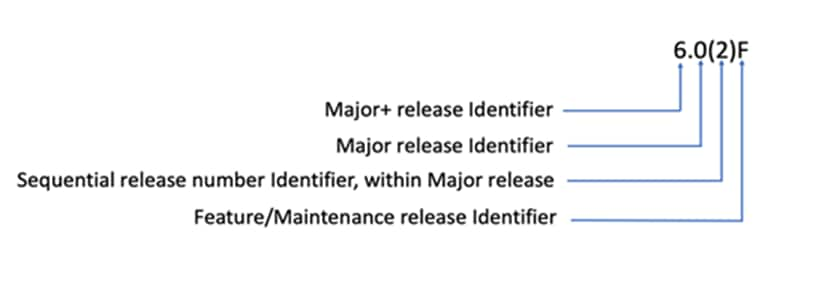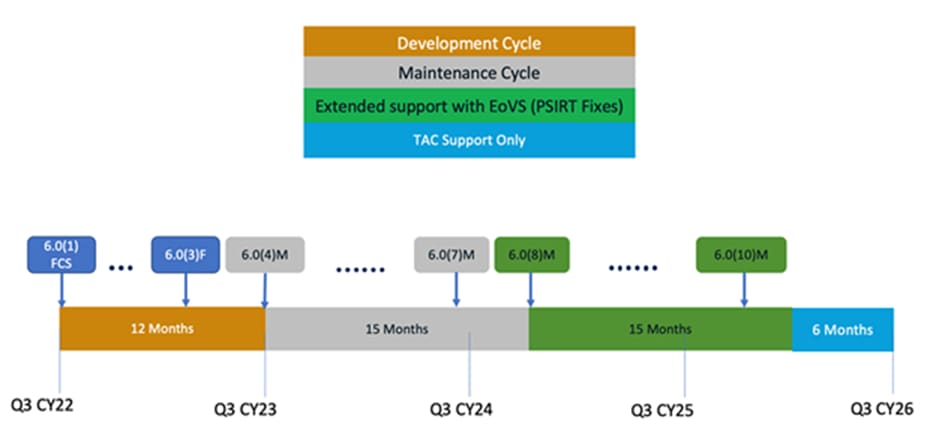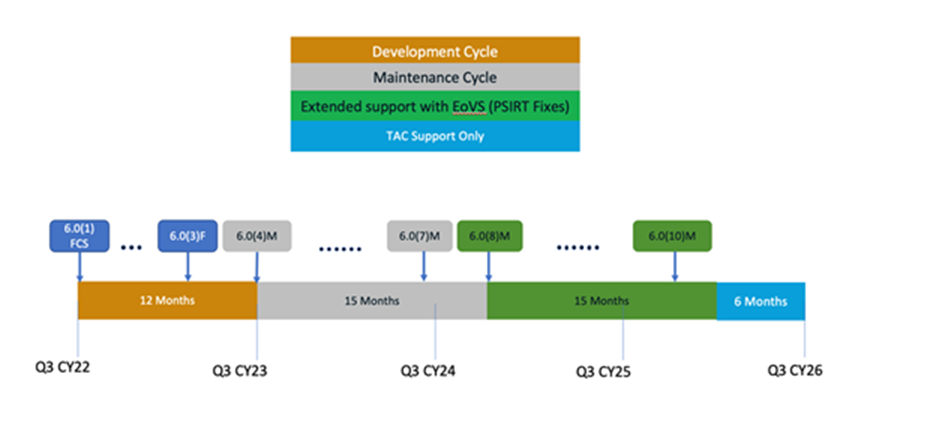Software Lifecycle Support Statement - ACI
Available Languages
Bias-Free Language
The documentation set for this product strives to use bias-free language. For the purposes of this documentation set, bias-free is defined as language that does not imply discrimination based on age, disability, gender, racial identity, ethnic identity, sexual orientation, socioeconomic status, and intersectionality. Exceptions may be present in the documentation due to language that is hardcoded in the user interfaces of the product software, language used based on RFP documentation, or language that is used by a referenced third-party product. Learn more about how Cisco is using Inclusive Language.
A comprehensive Cisco ACI Software release methodology has been developed to both preserve the integrity and stability of mission-critical networks and has the flexibility to respond to market needs for timely delivery of advanced networking features with multilayer intelligence.
This software lifecycle support statement is a guide to understanding the Cisco ACI Software release lifecycle. It describes the types of releases, their functions, and their timelines. It also describes the Cisco ACI Software release and image naming conventions.
Types of Cisco ACI Software Releases
Table 1 lists the Cisco ACI Software release variants: Major+, Major releases or trains, Feature releases and Maintenance releases.
Table 1. Cisco ACI Software Release Types
Each Cisco ACI Software release is uniquely numbered as A.B(C)x, where A is the Major+ release or train, B is a Major train that enhances a Major+ release, C is the numerical identifier of the sequence within the Major train and x represents if this release is a Feature release or a Maintenance release.
Figure 1 is an example showing graphical representation of the Cisco ACI Software releases

Cisco ACI Software releases
Lifecycle of a Cisco ACI Software Release
Previously, ACI releases were designated as either a long-lived or a short-lived release. From ACI 6.0 release onwards, all Major releases are treated equally, and all major release trains will be designated as the recommended release at various points within their lifecycle. Figure 2 represents the lifecycle of the ACI 6.0 release.

Example of Lifecycle of ACI software release
The lifecycle of an ACI release goes through 4 phases. These phases also align with various stages in the End-of-Life process.
1. The lifecycle of a Major release starts with Feature Development Phase. This phase starts with First Customer Shipment (FCS) or the first release, on the Major train. It represents the date of the first shipment of a software release to customers. There are 2 additional releases over the subsequent 12 months on this major train, where new features and enhancements are introduced. The EOS announcement, as part of the EOL process is designed to coincide with FCS, to provide customers visibility into the EOL milestones and support timelines for the major release.
2. At 12 months post FCS, the major release then enters the Maintenance Phase. This maintenance phase extends over 15 months, with regular software releases, where any potential defects or Security Vulnerabilities (PSIRTs) are addressed. No new features or enhancements are introduced during this phase, to ensure software stability.
3. At 27 months post FCS, it enters the Extended Support Phase, under which it receives only PSIRT fixes. This date aligns with the End of Software Maintenance milestone in the EOL process.
4. At 42 months post FCS, it enters the TAC Support phase, where customers can continue to get software support from Cisco TAC, and an upgrade to a subsequent Major release will be required for defect fixes. This date aligns with the End of Vulnerability and Security Support (EoVS) milestone in the EOL process. At 48 months post FCS, no support will be provided for this Major release.
Note: For HW products running ACI software, customers will receive Critical vulnerability(PSIRT’s) support through HW LDOS on the final extended maintenance ACI release
ACI will continue to innovate across Major releases, all the while, providing a reliable and stable version of ACI to our customers.
A new Major release, is planned every year, enabling customers to take advantage of new features and hardware in this new major release, while allowing other customers to remain on the previous Major and recommended release, for those who want the reassurance of regular releases, focused solely on defect fixes.
An example of major release timelines and milestones are outlined below in Fig 3.
Be mindful that the below illustration is just an example, and the release numbering is based on criteria mentioned in Table 1.

Example of Major Release Timelines and Milestones
Table 2. ACI OS EoL Milestones
| ACI Software Train |
EoSWM Date |
EoVSS Date |
LDoS |
| 6.0(x) |
Nov 30 2025 |
Feb 28 2027 |
Aug 31 2027 |
The Cisco ACI cadence-based software release methodology preserves the integrity, stability, and quality of customers' mission-critical networks. It has the flexibility to respond to market needs for timely delivery of innovative features. Primary attributes of release methodology include the following:
● Major releases introduce significant new features, functions, and platforms
● Feature releases enhance the features and functions of ACI.
● Maintenance releases address product defects
● Cisco ACI release notes: https://www.cisco.com/c/en/us/support/cloud-systems-management/application-policy-infrastructure-controller-apic/tsd-products-support-series-home.html
● Cisco APIC and Nexus 9000 Series Switches minimum recommended Cisco ACI releases: https://www.cisco.com/c/en/us/td/docs/switches/datacenter/aci/apic/sw/recommended-release/b_Recommended_Cisco_ACI_Releases.html
● Cisco APIC End of Life, End of sales announcements: https://www.cisco.com/c/en/us/products/cloud-systems-management/application-policy-infrastructure-controller-apic/eos-eol-notice-listing.html
● Cisco Nexus 9000 End of Life, End of Sales Notices: https://www.cisco.com/c/en/us/products/switches/nexus-9000-series-switches/eos-eol-notice-listing.html